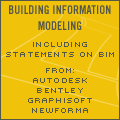Why Don't We Do It in the Road Ahead?
—Part 3, Security Enhancement
LaiserinLetterLetters™
Laiserin's Lemma™—Power to the People
Today's Top-Level Take-Away—Change Management
> Robert Palmer, CEO of minicomputer pioneer Digital Equipment Corp. (DEC) during its waning days prior to being absorbed by Compaq Computer (itself since absorbed by Hewlett-Packard), observed:
> "One of the most important things you can ever learn as a leader is to separate what needs to be done from how hard it is. Otherwise, you always talk yourself into some incrementalism that you think you can live with, but it's never good enough."
> Or, in the words of comedian "Professor" Irwin Corey:
> "If we don't change direction soon, we'll end up where we're going."
Why Don't We Do It in the Road Ahead?
�Part 3, Security Enhancement
The key issues to which AEC/FM and plant/process technologists should direct this year's management attention and technology budget can be grouped into three clusters: Infrastructure Realignment; Application Integration; and Security Enhancement. We looked at Infrastructure Realignment in IssueTwentyOne and Application Integration in IssueTwentyTwo. In this and coming issues we explore Security Enhancement, which includes four of the Top Twelve Tech Trends for 2003�Business continuity planning, e-signatures, Identity management and Digital rights management (DRM). In recent months these technologies have begun to assume such importance that each now deserves broader and deeper coverage. Herewith,
> Business continuity planning
and its sub topics:
>> Computus interruptus
>> Backing up is hard to do
>> The road to recovery
![]()
![]()
LaiserinLetterLetters™
An occasional sampling of reader electron-mail, or "keep those waves and particles pouring in, folks!"
More...
![]()
![]()
Laiserin's Lemma™—Power to the People
(lemma: a short theorem used in proving a larger theorem)
During the first third of the last century, a now-forgotten techno-pundit predicted that telephone operators would soon comprise a majority of the industrialized workforce—to manually route the burgeoning volume of local, long-distance and international phone calls. However, the innovation of direct dialing—with its international access codes, country codes and area codes accessed through the simple phone keypad interface—proved that prediction false by moving control over telephone connectivity behavior out of the hands of trained operators and into the reach of end users. Today, a comparable transfer of control is shaping up in design and analytic software—shifting power from software developers' pre-programmed or custom-coded functionality to end-user interaction and flexibility. Whether identified as multi-agent systems, parametric systems, genetic algorithms or hybrids of these techniques, new and emerging software tools will empower users to manipulate the behavior of their software—directly through simple interfaces, yet without programming.
Software with behavior that is modifiable by end-users is more likely to suit the constantly shifting nature of the work at hand than is fixed-function software in which programmers (by definition closer to the code than the tasks for which they're coding) try to out-guess what end-users really need. Early commercial and research examples of this trend range from: the drag-and-drop workflow design capability in OpenText's LiveLink for Construction; the work of the SmartGeometry Group with Bentley Systems' infelicitously named "Generative Components"; and diverse research on multi-agent systems for design and construction at universities such as Stanford (PDF) and Sydney. The bottom line? Workers in AEC/FM, plant/process and infrastructure businesses soon will be able to make their software work the way they work, rather than changing their work to fit the hard-coded constraints of their software.
More...
![]()
![]()

















